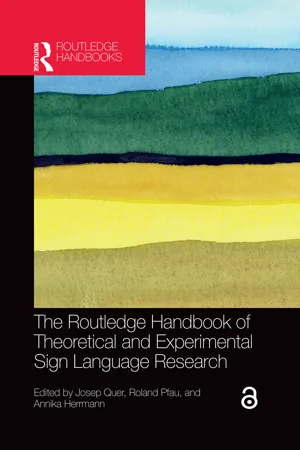
The Routledge Handbook of Theoretical and Experimental Sign Language Research
- 704 pages
- English
- ePUB (mobile friendly)
- Available on iOS & Android
The Routledge Handbook of Theoretical and Experimental Sign Language Research
About this book
The Routledge Handbook of Theoretical and Experimental Sign Language Research bridges the divide between theoretical and experimental approaches to provide an up-to-date survey of key topics in sign language research. With 29 chapters written by leading and emerging scholars from around the world, this Handbook covers the following key areas:
- On the theoretical side, all crucial aspects of sign language grammar studied within formal frameworks such as Generative Grammar
- On the experimental side, theoretical accounts are supplemented by experimental evidence gained in psycho- and neurolinguistic studies
- On the descriptive side, the main phenomena addressed in the reviewed scholarship are summarized in a way that is accessible to readers without previous knowledge of sign languages
Each chapter features an introduction, an overview of existing research, and a critical assessment of hypotheses and findings. The Routledge Handbook of Theoretical and Experimental Sign Language Research is key reading for all advanced students and researchers working at the intersection of sign language research, linguistics, psycholinguistics, and neurolinguistics.
Chapters 5, 18 and 19 of this book are freely available as a downloadable Open Access PDF at http://www.taylorfrancis.com under a Creative Commons [Attribution-Non Commercial-No Derivatives (CC-BY-NC-ND)] 4.0 license.
Frequently asked questions
- Essential is ideal for learners and professionals who enjoy exploring a wide range of subjects. Access the Essential Library with 800,000+ trusted titles and best-sellers across business, personal growth, and the humanities. Includes unlimited reading time and Standard Read Aloud voice.
- Complete: Perfect for advanced learners and researchers needing full, unrestricted access. Unlock 1.4M+ books across hundreds of subjects, including academic and specialized titles. The Complete Plan also includes advanced features like Premium Read Aloud and Research Assistant.
Please note we cannot support devices running on iOS 13 and Android 7 or earlier. Learn more about using the app.
Information
1
Sign language phonology
Theoretical perspectives
1.1 Introduction
1.2 Basic units and constraints
| (1) | Examples of unmarked handshapes, locations, and movements7 | |
| a. | Handshapes: B (    | |
| b. | Locations: Neutral space, Chest | |
| c. | Movements: Downward path, End contact (hand touching a location) | |
Table of contents
- Cover
- Endorsement
- Half Title
- Series Information
- Title Page
- Copyright Page
- Table of Contents
- List of figures
- List of tables
- List of contributors
- Preface
- Editors’ acknowledgments
- List of notational conventions
- List of abbreviations of non-manual markers
- List of sign language acronyms
- 1 Sign language phonology: theoretical perspectives
- 2 Phonological comprehension: experimental perspectives
- 3 Lexical processing in comprehension and production: experimental perspectives
- 4 Prosody: theoretical and experimental perspectives
- 5 Verb agreement: theoretical perspectives
- 6 Verb agreement: experimental perspectives
- 7 Classifiers: theoretical perspectives
- 8 Classifiers: experimental perspectives
- 9 Aspect: theoretical and experimental perspectives
- 10 Determiner phrases: theoretical perspectives
- 11 Content interrogatives: theoretical and experimental perspectives
- 12 Negation: theoretical and experimental perspectives
- 13 Null arguments and ellipsis: theoretical perspectives
- 14 Null arguments: experimental perspectives
- 15 Relative clauses: theoretical perspectives
- 16 Role shift: theoretical perspectives
- 17 Use of sign space: experimental perspectives
- 18 Specificity and definiteness: theoretical perspectives
- 19 Quantification: theoretical perspectives
- 20 Implicatures: theoretical and experimental perspectives
- 21 Discourse anaphora: theoretical perspectives
- 22 Discourse particles: theoretical perspectives
- 23 Logical visibility and iconicity in sign language semantics: theoretical perspectives
- 24 Non-manual markers: theoretical and experimental perspectives
- 25 Gesture and sign: theoretical and experimental perspectives
- 26 Information structure: theoretical perspectives
- 27 Bimodal bilingual grammars: theoretical and experimental perspectives
- 28 Language emergence: theoretical and empirical perspectives
- 29 Working memory in signers: experimental perspectives
- Index